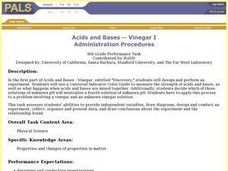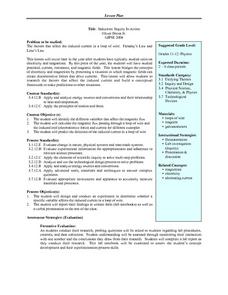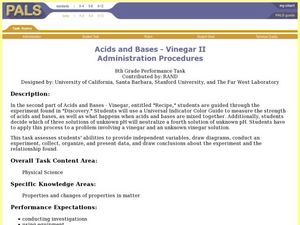Curated OER
Investigating the Biosphere with Planetary Models
Students model the biosphere and manipulate variables affecting change and plan their experiments with the help of others. They describe their question, hypothesis, and methods of investigation.
Curated OER
Bubbles
Students complete experiments with three different bubble solutions to determine which one creates the largest bubbles. Before conducting the experiments, they discuss the ingredients in each solution, and make predictions on which will...
Curated OER
Acids And Bases -- Universal Indicator
Eighth graders design and perform an experiment that uses a Universal Indicator Color Guide to measure the strength of acids and bases. They also determine happens when acids and bases are mixed together. They decide which of three...
Curated OER
Revised “Understanding Nutrition” Activity
Students evaluate their current food choices. In this health science lesson, students test different drinks to rate the amount of Vitamin C content. They discuss results in class.
Curated OER
Sow Bug Habitats
High schoolers conduct an experiment to determine what type of environment sow bugs prefer. They use petri dishes with partially wet paper towels to assess whether they prefer wet or dry habitats.
Curated OER
What Do Plants Need to Grow?
Fourth graders control variables to determine the effect on plant growth. They collect information by observing and measuring and construct simple graphs, tables, maps and charts to organize, examine and evaluate information.
Curated OER
Biodegradable Plastics
Students prepare a type of biodegradable plastic. They design method(s) to compare its properties with some common plastics that are readily available in the market. They later advance to identifying variables in an experiment and fair...
Curated OER
An Investigation into Effects of Rhizobium Soil Bacteria on Nitrogen Availability
Students identify the control and the variables in the experiment. They describe the growth of plants with and without nitrogen fixing bacteria, then name the bacterium responsible for making nitrogen available to the plant.
Curated OER
Soil Sample Lab 2
Students examine each soil sample and record observations. In this biology lesson, students design an experiment to test soil flow rate. They write a lab report about the experiment.
Curated OER
Mountain Building
Fourth graders identify variables that influence rates of change. They, through group consensus and using the assigned materials, design and build what they believe to be the strongest mountain possible.
Curated OER
Testing the Hypothesis
Middle schoolers create and conduct various experiments to determine the origin of a family artifact, and then determine whether their results were successful. Students summarize their results and evaluate whether their hypotheses were...
Curated OER
Induction: Inquiry in Action
Students investigate the factors that affect the induced current in a loop of wire. They discuss Faraday's Law and Lenz's Law. Students identify the different variables that affect the magnetic flux and calculate the magnetic flux...
Curated OER
Batteries in Series: Voltage and Light Intensity
Young scholars participate in a hands-on activity to explore the relationship between the number of batteries in a series circuit and its voltage. Students identify the relationship between two variables and plot points on a graph.
Curated OER
Smog City - Part II
Students create an experiment about ozone levels using a Smog City Simulation on the Internet. They complete a worksheet and study associated vocabulary.
Curated OER
Volumw Measurement, English System
Eighth graders biew each volume container and discuss where they have seen them in their home, and how they have seen them used. They explore the different names of volume sizes and their equivalents towards one another. Students...
Curated OER
Acids and Bases - Vinegar II
Eighth graders experiment what happens when acids and bases are mixed together. In this acids and bases experimental instructional activity, 8th graders decide which of three solutions of unknown pH will neutralize a fourth solution of...
Curated OER
Yeast Cells and Their Environment
Students create their own experiment in which they have yeast cells growing in liquid environments. They examine the relationship between humans and microorganisms. They also practice using the scientific method.
Curated OER
The Effects of Ultra-Violet Light on Yeast
Learners work in small groups collecting and analyzing data as they learn how to best grow yeast. This lesson allows students to conduct several student-created experiments as they continually generate questions and hypotheses. ...
Curated OER
Antibiotic Resistance in E. coli
Learners discuss the antibiotic resistance of bacteria. They design an experiment to test the resistance of different strands of E. coli. They answer discussion questions to end the lesson.
Curated OER
Bungee Man Lab
Students explore the motion of a toy bungee jumper using the scientific method. They view a video of a bungee jumper and discuss what can be measured about a bungee jump. Students discuss the scientific mehtod and how to design an...
Curated OER
Examining Infiltration Rates of Various Soil Types
Students formulate their own hypothesis, determine which variables are important to test their hypothesis, design an experiment in which they collect data. They utilize instruments and tools to measure, calculate, and organize data.
Curated OER
The Sun, Earth's Angles, and the Seasons
Young scholars determine if the angle of light bombardment is a factor in heat absorption. They correlate these findings to the tilt of the Earth and the seasons. Students fold a pice of black construction paper in half, lengthwise. They...
Curated OER
Electricity – Ohm’s Law
Students investigate the relationship between voltage and current. In this physics lesson, students observe and collect data from the experiment. They graph the result and share them to class.
Curated OER
Your Body's Building Blocks
Students study the elements of the Periodic Table as they relate to the building blocks of the body. They experiment to measure the amount of iron in the body.























